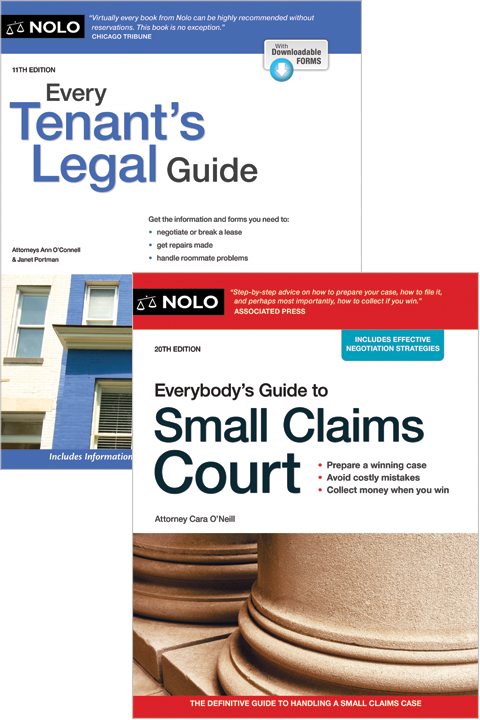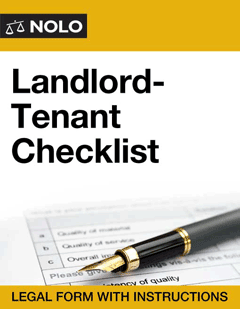Here’s an overview of the steps involved with filing a security deposit lawsuit in California.
Fights over security deposits make up a large percentage of the landlord-tenant disputes that wind up in small claims court. Typical lawsuits are brought by tenants against landlords who unfairly withheld deposit money for cleaning, repairs, or back rent, or failed to return the deposit at all. Fortunately, it's fairly simple to file a small claims lawsuit in California. Here's an overview of the steps involved with doing so.
Know California's Rules for Returning Deposits
Before you head off to court, make sure you have a clear understanding of relevant state security deposit rules on when and how landlords must return deposits. For example, in California, landlords have 21 days to itemize and return your deposit, and the landlord must provide tenants with advance notice of intended deductions, which is generally done in a pre-move out inspection (the second inspection is done when the tenant leaves). (Cal. Civ. Code § 1950.5 (2024).)
The itemization should be in writing and state how the deposit has been applied toward back rent and costs of cleaning and damage repair, together with whatever is left of the deposit.
Typically, landlords may use deposits to cover:
- Unpaid rent—for example, if you leave without giving enough notice. Make sure you've followed California's rules for ending a tenancy or, if you have a lease, proper procedures for ending a fixed-term lease, so there's no confusion as to any rent-related deductions your landlord may take.
- Unpaid utility charges or other lease or rental agreement financial obligations.
- Repairing the damage that you, a guest, or pet caused to the premises, except for "ordinary wear and tear."
- Cleaning the premises to the level of cleanliness that existed at the start of the tenancy, if necessary, when you leave. Your landlord should not deduct cleaning costs from your deposit if you have paid a separate, nonrefundable cleaning fee.
- Payment for undoing changes you made to the property—for example, to pay for the removal of hardware you left on the wall where your flat screen TV was installed.
For details on state security deposit rules, including exemptions and statutory citations, see Landlord-Tenant Laws in California.
Ask to Attend the Landlord's Final Inspection
After you move out, your landlord will need to inspect the rental unit to assess what cleaning and damage repair is necessary. Many landlords do this on their own and will simply send you an itemized statement with any remaining balance of the deposit. Ideally, your landlord will have used some kind of inventory or Landlord-Tenant Checklist when you moved in, so you can compare the condition of the rental at the start and end of the tenancy.
It's also a good idea to photograph or videotape the rental unit before you leave so that you have visual proof of the condition of the rental unit to present in court. Ideally, you will have also done this you moved in, so you have before and after photos.
If you have done a thorough job of cleaning and fixing any damage that you (or your pet or guest) caused, hopefully, the landlord will return all or most of your deposit. (California state law requires that the landlord provide you with advance notice of deductions.) If the landlord has identified problems that you feel are your responsibility, ask if you can do more cleaning (or repair any damage identified in the final inspection) before the landlord takes deductions from your deposit.
Request Your Deposit in Writing
If your landlord has not returned your deposit or provided an itemization of deductions by the state deadline, or the landlord has taken deductions that you don't believe are justified, ask in writing for the return of your deposit. Your letter should spell out the main facts, your legal rights, what exactly you want, and your intent to sue in small claims court if necessary. Sending some kind of demand letter like this is important for several reasons:
- It's a chance to give your landlord your forwarding address (something you should have done when you gave notice to move out, but it's a good idea to provide it again).
- It's an opportunity to build your case for a small claims lawsuit.
- Your letter makes it more likely that you'll get a penalty or punitive damages (available in many states) if the landlord fails to follow the security deposit law.
See our sample demand letter for return of security deposit for a template to write your own. Edit the demand letter to cover the specific details of your dispute, and send it by certified mail (return receipt requested), or use a delivery service that will give you a receipt establishing delivery. Keep a copy of your letter and the delivery receipt. You'll need them if you end up in court.
If your landlord has not given you a satisfactory response to your demand letter, you may file a lawsuit immediately, or try mediation first, a procedure in which you meet with a neutral third person who helps you and your landlord arrive at your own solution. Mediation might be available from a community-based mediation program, or even right in the courthouse. In some cases, the court may require you to try mediation before suing your landlord, so check with your court for details on this.
Suing Your Landlord in California Small Claims Court
Suing your landlord is inexpensive, usually less than $50 to file a case (fee waivers or deferrals are sometimes available for people with low incomes). You don't need a lawyer—in fact, they're not even allowed in some cases. Disputes usually go before a judge (there are no juries) within a month or two.
You can sue for the amount of the security deposit that your landlord wrongfully withheld, up to the state limit. The maximum amount for which you can sue in California Small Claims Court is $12,500.
See the California state court website for more details on small claims lawsuits, including the name of the court where you should file suit, the paperwork involved with suing your landlord (typically called a complaint or claim), filing fees and other costs, and whether or not attorneys are allowed in small claims court disputes in California.
Gathering Evidence for Court
In addition to knowing your state security deposit rules, tangible evidence is key to winning your case in small claims court. Here are the types of evidence you should take to court (what you need depends on the specifics of your case):
- a clear statement of how much money you claim your landlord owes you, and any penalties or other fees you seek, such as interest on the deposit (if required by your state or city)
- a copy of your demand letter and other correspondence with your landlord regarding the deposit
- a copy of your signed lease or rental agreement and any written guidance your landlord provided on deposits and cleaning, including state-required disclosures on security deposits
- a copy of your state (and any local) security deposit law
- receipts or canceled checks for your security deposit and/or any cleaning fee you paid your landlord
- any move-in and move-out inventories, photos, and/or videos of your rental unit that show the condition of your property at the start and/or end of your tenancy
- one or two witnesses who were familiar with your rental unit and will testify that you left the place clean and in good repair, and
- anything else relevant to your case.
Preparing for and Presenting Your Case in Court
Small claims courts are informal places, but you might want to consider watching a few cases a few days before your court date, so you know what to expect. Also, many court websites provide useful advice, and some courts even offer free legal advisor programs to help prepare your case properly. Before you go to court, practice your presentation with a friend or relative, so that you can make your case in an efficient and convincing way, backed up with relevant evidence.
The trial consists of both you and your landlord explaining your point of view of the dispute and presenting any evidence or witnesses. Explain and document your case thoroughly, but be brief and succinct. Describe your loss and how much you are asking for. Then go back and tell the story chronologically, and present the evidence you've collected to support your case.
If you brought witnesses, point them out to the court, summarize the testimony you expect they will give, and ask permission to call them. Your testimony will typically take less than 15 minutes, and the judge either announces a decision right in the courtroom or mails it within a few days.
If you don't agree with the court ruling, you might be able to appeal it.
More Information on Small Claims Court and Security Deposits
Nolo's Small Claims Court & Lawsuits section provides a wide variety of articles on small claims court. It also includes general articles on what to do if you are sued in small claims court, how mediation works in small claims cases, how to file an appeal in a small claims court case, and more.
For dozens of articles on the use and return of deposits, see the Security Deposits section of the Nolo site.
For an overview of state landlord-tenant laws on security deposits and other issues, read Nolo's California Tenants' Rights and Nolo's Every Tenant's Legal Guide, a 50-state book covering everything from repairs and maintenance to termination procedures.
Talk to a Lawyer
Need a lawyer? Start here.
How it Works
- Briefly tell us about your case
- Provide your contact information
- Choose attorneys to contact you
- Briefly tell us about your case
- Provide your contact information
- Choose attorneys to contact you



